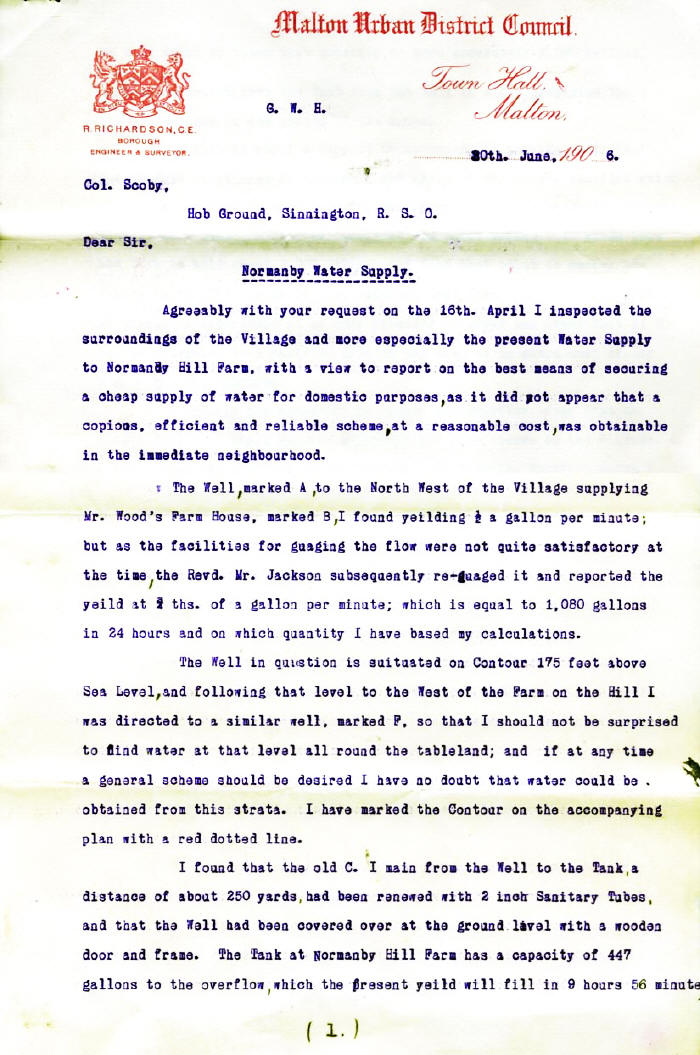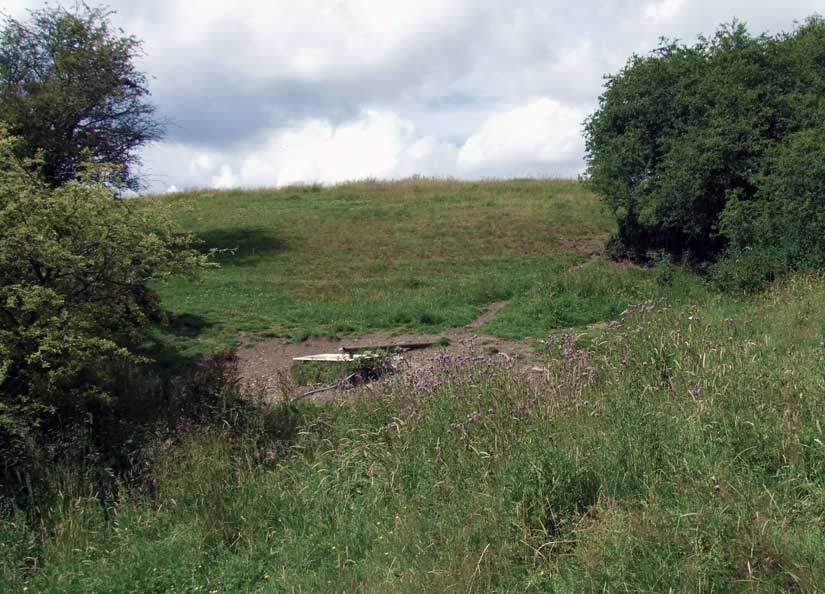Normanby's
first Water Supply (1907)
In August 1906 a
committee appointed by Normanby Parish Meeting
assembled in the school room to discuss how best to replace the ancient system
of carrying water for domestic purposes from the River Seven by bucket.
Most villagers went to the river through the churchyard. According to
George Hornby
(1917-2001) the water for drinking would be allowed to settle and
then might be boiled. On Sunday evenings, in readiness for washday, the
men of the village collected water for the women; they used a cobbled path on
the southern boundary of Pasture House which led to steps in the river bank,
and another path down the side of today's Halcyon Reach.
Led by the rector, the
Reverend E H M Jackson, the committee's main concern was to avoid the expense
of becoming ratepayers to the Kirkbymoorside Rural
District Council in "a general water supply system for all the beck side
villages below Rosedale." Over the next ten months subscriptions were
sought from local farmers and worthies (Lord Feversham
promised £5) and these amounted to £45-19s-6d. The eventual cost of the
scheme was to be £45-6s-0d.
The project depended on
the spring above the village. This allowed water to run under gravity
from Normanby Hill to the village street.
William Wood (1854-1939) of Normanby Hill Farm already had a
cistern which took in the spring water but he agreed in December 1906 to
permit the water overflowing from the cistern to be piped through his land to
a reservoir which would be built at the top of the rector's paddock.
From there pipes would convey the water "down the hedge side of the rectory
garden and Mr Wood's drive to the village street, to a standpipe to be erected
opposite the two houses known as West View and Rose Cottage." Wood's drive
was, of course, today's driveway to Normanby Hill
Farm. The standpipe was close to the school.
The concrete reservoir
measured 10 feet x 6 feet x 6 feet and could hold 2000 gallons. William
Gamble charged £17-13s-8d to build it but the committee expected to get the
necessary sand and gravel gratis with landowners' permission. The sand
would come from the river "near one of Mr Strickland's fields" (i.e.
near Lance Butts Farm) and the gravel from the river at
Sinnington. Farmers were asked to "lead" these materials for
free. This was a community pulling together.
Survey Report from Malton Council
Survey Report from Malton Council
Estimate from Malton Council
Section through Normanby Hill showing positions of contours
Mary Sleightholme's invoice for gravel signed for by Albert
c.1907 River Seven at Sinnington where the gravel was taken from.

Survey Report from Malton Council
Early May saw the arrival
of the "well fountain" (a fancy name for a standpipe which delivered water
from a surface spring, "well" being the local word for a spring). Given
the period, it was probably a lion's head pillar - such as can
still be seen at Gillamoor. On 27th May the
committee decided that they "should open the waterworks, which were now
completed so far as to allow the water to be turned on at the first stand post
which they had been able to erect." The rector suggested a religious
ceremony, in view of "the great benefit which would be conferred on the
inhabitants by the provision of this water supply", to be followed by tea and
entertainment for all the villagers at the rectory.
For the occasion the
Reverend Jackson wrote an order of service which has fortunately survived. On
Saturday 1st June 1907 the water committee was to stand near "the Pillar Well"
and the rector would read the lesson from Isaiah chapter 41: When the poor and needy
seek water, and there is none, and their tongue faileth
for thirst, I the Lord will hear them…I will open fountains in the midst of
the valleys."
Then William Wood
"turning the Stop-cock, to signify his gift of the water, shall present the
key to the Rector." After several prayers the rector's wife was to
"place her hand upon the handle of the Fountain, and turning it, say 'Spring
up, O well…for the satisfying of the needs of the inhabitants of this village,
both now and in the time to come.'"
Nearly a year later, on
4th April 1908, the Malton Messenger quoted the
rector's opinion that the scheme had saved the village ratepayers between one
and two thousand pounds (but over what period of time?) since they would
otherwise have been included in any general water scheme for the district.
Apart from this, it can be said that Normanby was
fortunate in having the interest of Dr Thomas Walsh Tetley
(1873-1953), the
Kirkbymoorside Medical Officer of Health who lived
at Hob Ground. He was currently busy having Joseph
Foord's open water races to Kirkbymoorside,
Nawton, Beadlam and
other villages replaced by piped systems. He was a stickler for the
quality of water sourced for human consumption. We can be sure that he
and the Rural District Council, acting under the Public Health Act of 1878,
had checked out Normanby Hill Spring.
However, keeping livestock away from the spring might have posed problems over
time.
It is not clear whether
more than one standpipe or "fountain" was set up in 1907. In the 1990s
George Hornby told Clare Wallis that during the
1930s three standpipes were laid in the village: one by the chapel, one
opposite Willow House (i.e. where the 1907 pillar
fountain stood) and one opposite the church (i.e.
next to Fernleigh 2009); certainly elderly inhabitants
now recall three in the past. (A fourth standpipe was on the opposite side of
the road to the present day BT Telephone box serving the north end of the
village.)
It should be noted that
William Wood of Normanby Hill farm was born at Pockley he and his father
Charles (1823-1881) were renown farmers and butchers they were not connected
to The Wood family of Askew, Bridge farm, Willow House and Yew Cottage
(Margaret's family).
Bernard Frank also has a
record of a ten-foot standpipe near the bridge, used for filling traction
engines. (See Photograph of Railway Engine derailment at Barn Farm).
There was also a well of 6ft diameter which was some 8ft from the back door of
the village shop. Tom and Dot Sleightholme
used it regular in the early 50's. It was filled in when the row of
cottages were demolished.

The Spring source in 2009
Sources
Order
of service, 'Dedication of
Normanby
Village Water Supply' Sat 1st June 1907 and other letters/documents held by
Bernie.
Top